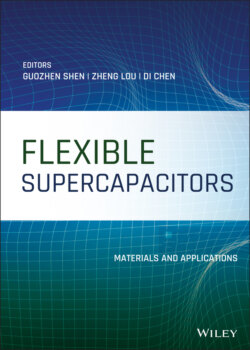Читать книгу Flexible Supercapacitors - Группа авторов - Страница 12
1.2 Configurations of AFSCs Device
ОглавлениеSpecifically, AFSCs device can be fabricated by constructing two flexible dissimilar electrodes (a Faradaic positive electrode and a capacitor‐type negative electrode), a separator and, in most cases, quasi‐solid‐state electrolyte in a soft package. Among various types of quasi‐solid‐state electrolytes, gel polymer electrolytes have been extensively used in FSCs due to its relatively high ionic conductivity [36–40]. Soft and bendable plastics including polyethylene terephthalate (PET) [41–44], polydimethylsiloxane (PDMS) [45], and ethylene/vinyl acetate copolymer (EVA) film [46] are typically used as packaging materials for FSC devices.
Considering that the fundamental limit of energy storage capability is largely determined by the electrode material, either the material choice or structure design of electrode materials are of vital importance. Apart from directly fabricated freestanding films like carbon nanotube (CNT) films [47, 48] and graphene films [49, 50], previous reports for FSCs indicate that the flexible electrodes can also rely on a flexible substrate such as thin metal foils [51, 52], polymer substrates [53], textiles [54], and papers [55], to provide flexibility. The main differences between the AFSCs and SFSCs are that the AFSCs require that the positive and negative electrodes are not the same, but they need to be matched well. Electrode materials that are dominated by Faradaic reactions such as metal oxides (RuO2 [56, 57], MnO2 [58–64], CoO [60,65–67] NiO [68–70], V2O5 [71, 72], etc.), metal sulfides (NiCo2S4 [73–75], MoS2 [76], CoS2 [77, 78], NiS [58, 63, 79, 80], etc.) and conductive polymers (polyaniline (PANI) [32, 81], polypyrrole (PPy) [82, 83], poly (3,4‐ethylenedioxythiophene) (PEDOT) [84, 85] etc.) are normally applied as positive electrodes in AFSCs due to their high specific capacitance and relatively higher potential window. Notably, carbon‐based materials (activated carbon [60, 66, 67], graphene [59, 86], CNTs [87], carbon fibers [88–90] etc.), metal nitrides (TiN [20], VN [91], MoN [92], etc.), and some metal oxides (FeOx [93], MoOx [94] etc.) are usually employed as negative electrodes because of their fast charging/discharging rate and suitable working window at negative potential.
However, before they are assembled in an AFSC, the matching problems of the two electrodes with different theoretical capacitance need to be solved [91]. As for an AFSC, the charge balance will follow the relationship q+ = q−. The charge stored by each electrode depends on the specific capacitance (C), the potential range for the charge/discharge process (E) and the mass of the active electrode material (m), following the Eq. (1.3):
(1.3)
In order to get q+ = q− at the typical current density, the mass balancing will follow the Eq. (1.4):
(1.4)
In this way, the suitable mass ratio between the positive electrode (m+) and negative electrode (m−) is defined, which is much closed to the mass loading of the active materials of positive and negative electrode in typical AFSCs.
